
Natural wine is the drink du jour. The trendy, funky new kid is popping up in small and exclusive quantities in wine stores and on restaurant menus throughout the country. This exciting frontier in viniculture, with its old-school, hands-off approach, produces some of the most beautiful bottles out there – if you can score some. But, like the term “natural” itself, natural wine is not a regulated phrase, so you best do some research before purchasing to ensure they’re getting what they asked for. If you’re looking to try this trend, bring this cheat sheet along so you know what you’re tasting.
What is Natural Wine?
Natural wine is a different kind of grape-growing approach, one where the winemaker keeps pesticides and chemicals out of the equation, letting the grapes breathe and come into their own before harvest. Seasonal whether patterns play a big factor in the wine’s flavour.

If the weather is hotter, the grapes will have more sugar, producing more alcohol upon fermentation. If the season is cooler, the grapes will be dry (less sweet), producing less alcohol upon fermentation, and possibly fermenting slower. Unlike some mainstream wines that are built on repetition and familiar taste, natural wines go with the flow, making a dynamic and exciting range of flavours each year. Most natural wine should be sulfur-free, a big risk for oxidation, so it’s to be enjoyed fresh, not aged. Some wineries which incorporate natural processes and wild fermentation, opt to add sulphites to preserve it for shipping and storage.
Related: Crowd-Pleasing Canadian Wines for Under $15
How is It Made?
Natural wineries make a point to differentiate themselves from large-scale productions, which often ferment the grapes in temperature-controlled rooms. Natural wines are made by taking what comes to them. This can include spontaneous fermentation, where wild yeasts existing in the air ferment the wine. Using wild yeast is an unpredictable method, making this process a true challenge. With each type of yeast, comes a different flavour. Yeasts can affect the mouth feel and aroma of wine, making natural wine making a gamble. But when it turns out right, it’s outstanding.

What Does Natural Wine Taste Like?
Because of their spontaneous nature, tastes can range from tropical to floral, skunky to sour or ultra-funky. Some bottles are clear, some are cloudy; it depends on whether the wine is filtered or not.
Red, white, orange, rosé and sparkling wine – all of which begin with their own specific flavour – are transformed into something different based on terroir (the growing region and land), climate, grape varietal and when they are picked. The best thing you can do is sample your way to a favourite.
Where Can You Find Natural Wine in Canada?
Specialty retailers, wine bars and mail-order services are your best bet for getting a taste of natural wine. Restaurants with sommelier-run wine programs are another great place to try. For instance, The Black Hoof in Toronto has a knowledgeable staff of enthusiastic, on-trend wine aficionados who can help you find a natural wine to enjoy by the glass or bottle. In Montreal, Hôtel Herman’s lengthy, yet focused, wine list carries natural wines from around the world. Burdock and Co. in Vancouver offers a selection of natural wines served by a knowledgeable staff who can answer your toughest natural wine questions.
Related: Must-Try Local BC Wines
It’s not just found at restaurants. Pearl Morissette, a winery in Niagara’s famous winemaking region headed by a former Burgundian winemaker, is creating alluring natural wines with mystique, charm and sophistication, taking this from bohemian hipster trend to world-class treat. Their wines are available at their vineyard, online and in restaurants.
And, no matter where you are in Canada, you can order through Nicholas Pearce Wines, which carries one of my favourite natural wines, the Pearce Predhomme Chenin Blanc (South Africa). Grab a friend, order a case and split it – you won’t be disappointed.
Ask questions, request and seek out natural wine in your area. It’s worth the effort, not only for the thrill of the hunt, but the true difference in taste.
Photos courtesy of Allison Day
